L's Garden Checkpoint 6, 10 weeks later --
It's now 10 weeks since I started to informally chronicle L's garden progress. Mostly, the pictures are very boring except for 1 or 2 tomato pics.
First up is the plumeria we started from an unrooted cutting, growing in front of E's house. Three weeks ago it only had 4 leaves.
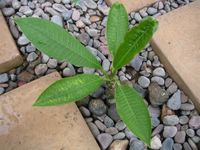
Plumeria with new leaf grown in
L's Arabian jasmine continues to grow well. I'll wait till early next spring to take a cutting and root it. I think her jasmine is one of the double- or triple-petaled kinds.

Perkier jasminum sambac
I've ripped out several instances of the unknown plant growing in the same pot as the aglaia odorata or Chinese rice/perfume plant, but another one inevitably rears its ugly head again.
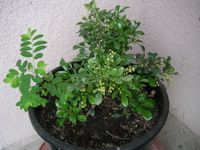
米子蘭, Aglaia odorata with the same unknown plant growing in
L's gardenia plants, about 7 in total, are all doing well, but one of her Gardenia jasminoides/augusta 'Mystery' plants is doing particularly well. It was busting out all over the place with flower buds and opened flowers.
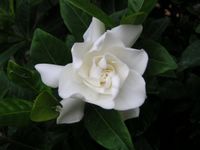
栀子花, Gardenia jasminoides 'Mystery' blossom
I'm not a good photographer, but I still try to take pictures of interest.
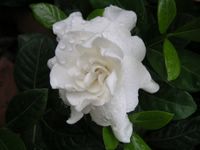
栀子花, Gardenia jasminoides 'Mystery', blossom with droplets
All of L's container tomato plants are dying off dramatically, but some tomatoes are still hanging on. I finally was able to pick 2 black seaman tomatoes from one of her unhealthier plants.

Black Seaman tomato plant
They were fairly small, smaller than typical, but that's b/c L hadn't been feeding them well and they were stuck in a 7 gallon nursery container. I'd say they were about 1.75" to 2.5" in diameter, the size of 4-6 of our Sweet Million cherry tomatoes.
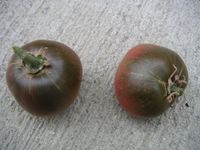
Black Seaman tomatoes
Here's the Italian Principe Borghese tomato plant. Most of its 70+ fruit have already been harvest. Probably in a few weeks L and I will rip it out and junk it.
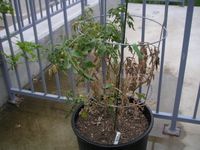
Principe Borghese tomato plant
L's Omar's Lebanese tomato plant looks relatively healthy, even if most of the lower growth had withered and been removed. Its tomatoes have been larger than the other tomatoes, but not as large as they should be.
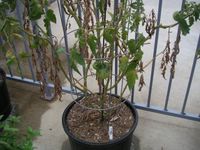
Omar's Lebanese tomato plant
The French Carmello plant has several green tomatoes waiting to ripen. The foliage looks somewhat healthier than the rest, like the Omar's Lebanese plant.

Carmello tomato plant
Actually the hybrid cherry tomato plant, Sweet Millions, is still going on strong. The foliage has probably held up the best, even though several of the branches are growing far out of the tomato cage.
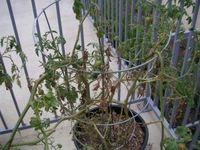
Sweet Millions tomato plant
L is pretty unobservant. I kept asking her if any flowers or fruit had developed on her Ping Tung Long Eggplant. She said no.

Pingtung Eggplant plant
But, lo and behold, when I checked them out I saw one plant with 6-8 fruit. There weren't any flowers, but the flower petals had already dropped and tiny green pea-sized fruit were growing in.
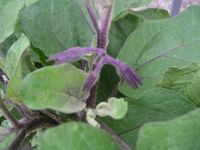
Pingtung Eggplant developing fruits
I'm not sure if there will be enough sunny days left for the eggplant to mature, but I certainly am hoping so.
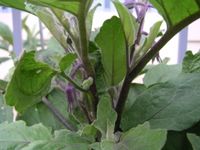
Pingtung Eggplant, young fruit appearing
L's Sweet Genovese Basil plants are growing woody. These past 3 weeks she has not been harvesting leaves, so the stems and leaves have been getting hard. I noticed flower clusters developing, so I cut off the stems with flowers on them, and also harvest a bunch of the leaves. I took a cutting to have it root on L's kitchen windowsill so she'd have a new plant to replace her old, tough one.

Sweet Genovese Basil, larger woodier plant
Here's a picture of the harvested tomatoes and tiny peppers that I think are chiltepin peppers. Not all the tomatoes shown below are ripe yet, but I picked those who had started to blush so they could ripen indoors safely away from insects and birds. There were omar's lebanese, black seaman, principe borghese, and sweet millions tomatoes.
I tried the black seaman tomatoes, and they were the best tasting out of all the ripened tomatoes from L's container garden. I told L that even though she wasn't wild about the tomatoes we started late this year, she should at least grow 1 black tomato.
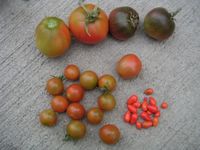
Picked tomatoes and peppers: sweet millions, principe borghese, black seaman, carmello
Here's the harvested Sweet Genovese Basil. L's mother washed the leaves, then left them out to dry a bit in the kitchen before freezing.
I tried the leaves and felt they tasted better cooked or with other ingredients; they didn't really taste good by themselves or in a plain leafy salad.
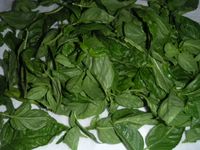
Picked basil
The other plumeria we rooted from cuttings was also showing some progress, albeit at a slower rate than the others.
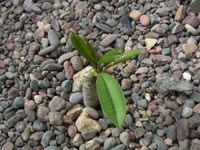
Backyard plumeria, with new leaves
The loquat tree I ordered bareroot via ebay has since dropped all its original dead or drying leaves so that only the healthy foliage grown after we planted it in the ground was showing.
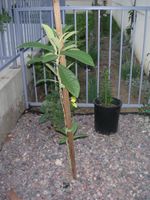
Backyard loquat tree, all old growth gone
Here are boring pictures of the plants lining E's patio. First up are the plants to the left.
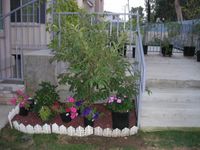
E's plot, facing patio, left
Next up are the plants to the right. L's strawberry guava tree is the small tree on the right.

E's plot, facing patio, right
And below is a bad picture of one of the handful of strawberry guava fruits growing in. They came late this year due to transplant shock, and we're not sure if there will be enough time for the fruit to mature in time before the rain and relative gloom rolls in.
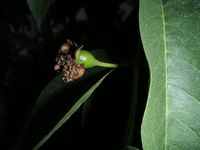
Strawberry guava fruit
E's front plots look much the same as ever, although the gardenia bushes are really growing happily. The leftmost gardenia plant is a Veitchii, but the other two are Gardenia 'Mystery' plants.
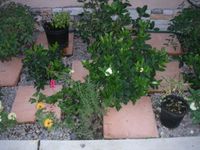
E's front plot, gardenia bushes in the middle
L thinks one of the over-the-cement-wall neighbor's morning glories seeded itself in the narrow plot lining E's walkway. She taped it up using foam tape.
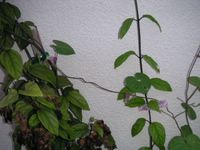
Volunteer morning glory, taped up
The only thing the developer's gardeners did right, in my opinion, was plant several osthmanthus bushes before May 2005. They are right now all sweetly fragrant. I'm not sure what type of osthmanthus, or 桂花 as these fragrant shrubs, native to China, are also called.

桂花, Osthmanthus flowers


0 Comments:
Post a Comment
<< Home